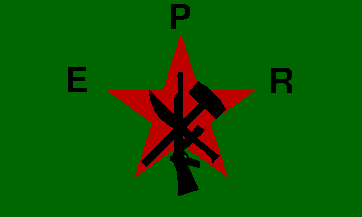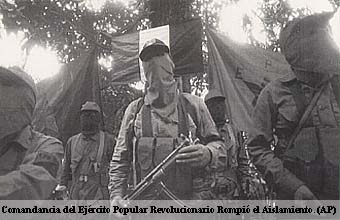
Popular Revolutionary Army

The self-declared "People's Revolutionary Army" (EPR) emerged from the southern Sierra Maestra of the state of Guerrero June 28, 1996 and its appearance was no surprise. Ever since the January, 1994 Zapatista uprising in Chiapas, it has seemed that a new guerrilla movement would soon surface in the sierra of Guerrero. This is what happened two years after the cease-fire between the Zapatistas and the Mexican Government. The second guerrilla group sprang up just north of Chiapas and government officials have been quick to label the rebels as "common criminals."
Guerrero has widespread
poverty and remote, tree-covered mountain ranges conducive to guerrilla
activity. No one in Mexico is quite sure just who or what the Popular Revolutionary
Army is. But since bursting on the scene, complete with olive uniforms
and AK-47s, the self-styled rebels have launched a series of coordinated
attacks against the government.
Their strength
is put at anywhere from 200 to 2,000. They are known as either Marxist
forming a textbook revolution or just plain armed thugs. They are the forerunners
of a peasant revolt or a fringe group much like the "militias" in the United
States.
 |
|
The EPR has had a lot of conflict with the Zapatista National Liberation Army (EZLN). Zapatista leaders have denied any involvement in the new guerrilla outbreak. Marcos, their leader, has commented that the Popular Revolutionary Army fights to seize power while the Zapatistas fight for democracy, liberty and justice. Indeed, it may be the EZLN's increasingly pacific posture that provoked the emergence of the EPR. Their sudden appearance underscores the fact that some groups still see the armed option as a viable vehicle for social change in Mexico.
There have been
many articles about the EPR all around the world. Even though they
are not as well known as the Zapatista movement, they have still made an
impact. One of the articles about the Popular Revolutionary Army's
actions was written in the Washington Post and can be found on line at
http://www.washingtonpost.com/wp-srv/inatl/daily/aug/28/mexico5.htm
Catch a Ride Back to the First Page
Pachakut'i
Zapatistas (EZLN)
Cultural Survival
Shuar Federation
Confederation of Indigenous
Nationalities of Ecuador (CONAIE)
Coordination Indigena de
la Cuenca Amazonica (COICA)
Sandinista National Liberation
Front (FSLN)
Bibliography